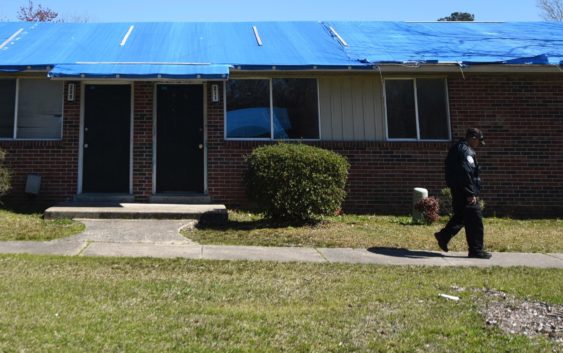- Seven months after Hurricane Helene, Chimney Rock rebuilds with resilience
- Wildfire in New Jersey Pine Barrens expected to grow before it’s contained, officials say
- Storm damage forces recovery efforts in Lancaster, Chester counties
- Evacuation orders lifted as fast-moving New Jersey wildfire burns
- Heartbreak for NC resident as wildfire reduces lifetime home to ashes
New Hanover County will craft evacuation, shelter plans as part of Florence response

Commissioners approve a pair of recovery and resilience plans
WILMINGTON — Monday, the New Hanover County Commissioners approved one plan to guide the region during future hurricanes and another to guide the long-term recovery for Hurricane Florence.
“Above all else, storm recovery requires patience. It is a slow, messy process, which your staff has thus far done a yeoman’s job of overcoming a lot of the obstacles and showing a lot of patience in going through this process,” said Dale Holland, a contractor hired by the county to aid its recovery. A full recovery could, Holland added, take five to seven years.
Approved Monday, the county’s recovery plan includes housing, making infrastructure such as creeks more resilient, bolstering the economic recovery, and better positioning the county for future storms.
“The objective of the long-term recovery plan is not just to restore the community to its pre-storm state, but leave our community in a better and more resilient position,” staff wrote in a memo to commissioners.
Part of the recovery plan approved Monday was determining which requested Hazard Mitigation Grant Program (HMGP) projects should be prioritized once funds are allocated.
“I expect the demand will far exceed what is going to be allocated by that program,” Beth Schrader, the county’s chief strategy officer, told commissioners, adding New Hanover County has asked for funds covering nearly $30 million in projects.
To that end, the plan prioritizes improving watersheds that flooded during Florence in order to help the most people and businesses, as well as improve the community’s resilience. According to documents prepared by the county, flooding damaged nearly 100,000 feet of creeks in the region, topped by 53,020 feet of Smith Creek.
Removing debris and sediment from creeks is followed on the county’s priority list by, respectively, buyouts of homes in the floodways, elevations in the 100-year flood zone, generator projects and all other projects.
Schrader also discussed the post-Florence affordable housing crisis, the impact of an already tight market that saw 1,200 affordable apartment units shuttered after the storm. Repairs are ongoing at some of those units, with Schrader saying the county hopes some will re-open in July and the nine-story Cape Fear Hotel will open in January.
In response to a question from Chairman Jonathan Barfield, Schrader gave assurances the county will work to grow the county’s affordable housing stock.
“If there’s a dollar that’s available that we can use to help the private sector build or use to to help the nonprofit sector build affordable housing,” Schrader said, “that’s something we, as a county, are going to jump all over.”
The board also voted unanimously to accept an after action report based on focus groups and interviews both within and outside the county. Tasks in the after action report included, among other items, leveraging faith groups and nonprofits to better communicate with residents; documenting effective plans that were improvised during Florence; and creating an inventory of the equipment that is necessary in disaster response.
“We have a lot of work that has been done, and we have a lot of work we still want to do before June 1,” said Jennifer Rigby, the county’s strategy and policy coordinator, referencing the official beginning of hurricane season.
Commissioners also tasked county staff with forming an evacuation policy, including zones and conditions; a sheltering policy, including the expected levels of service and the number of shelters; and an integration policy that would allow Wilmington employees to work in the New Hanover County emergency operations center during a disaster.
On the evacuation point, Commissioner Woody White, who was chairman when the storm struck in September recalled a phone call involving him, Gov. Roy Cooper, Wilmington Mayor Bill Saffo and New Hanover County Manager Chris Coudriet. Cooper, White recalled, was ready to declare a mandatory evacuation for all coastal counties, which would have involved evacuating hospitals and jails, ultimately holding off at the request of the local officials.
“To the general public: When the mayor and the county chairman are trying to decide, really, what should we do in that regard, it’s not an easy decision,” said White, who added any evacuation policy must be clear and unambiguous, possibly including recommendations for different categories of storm.
Reporter Adam Wagner can be reached at 910-343-2389 or Adam.Wagner@GateHouseMedia.com.